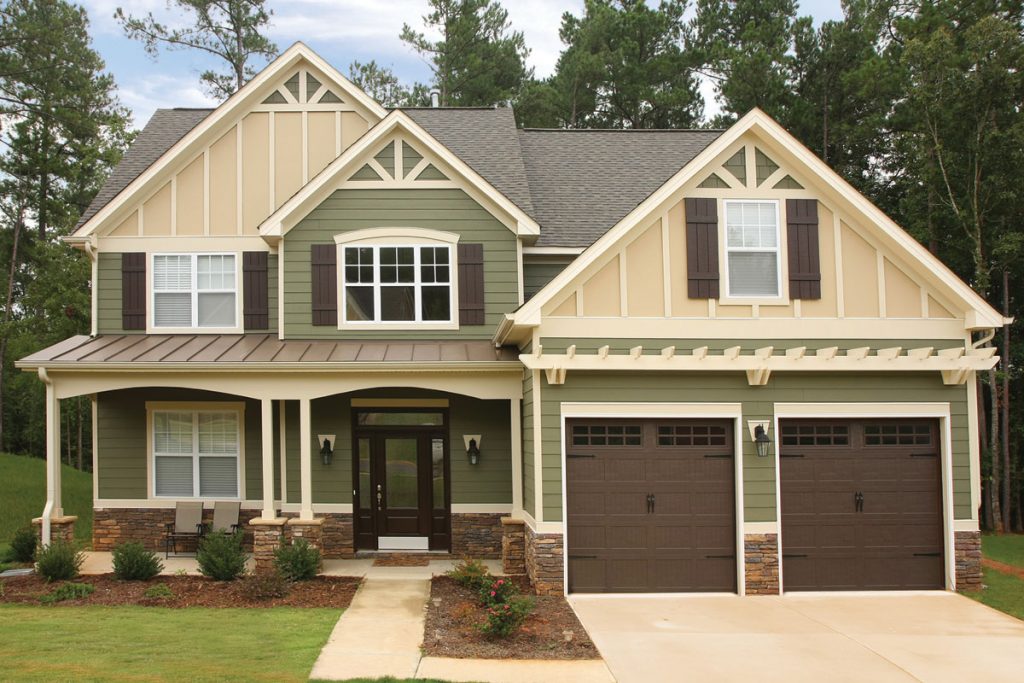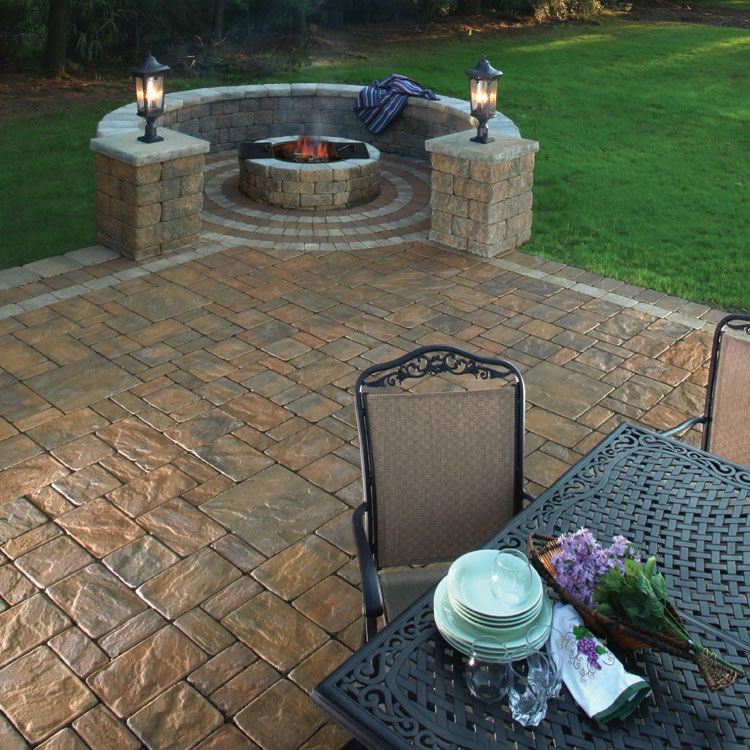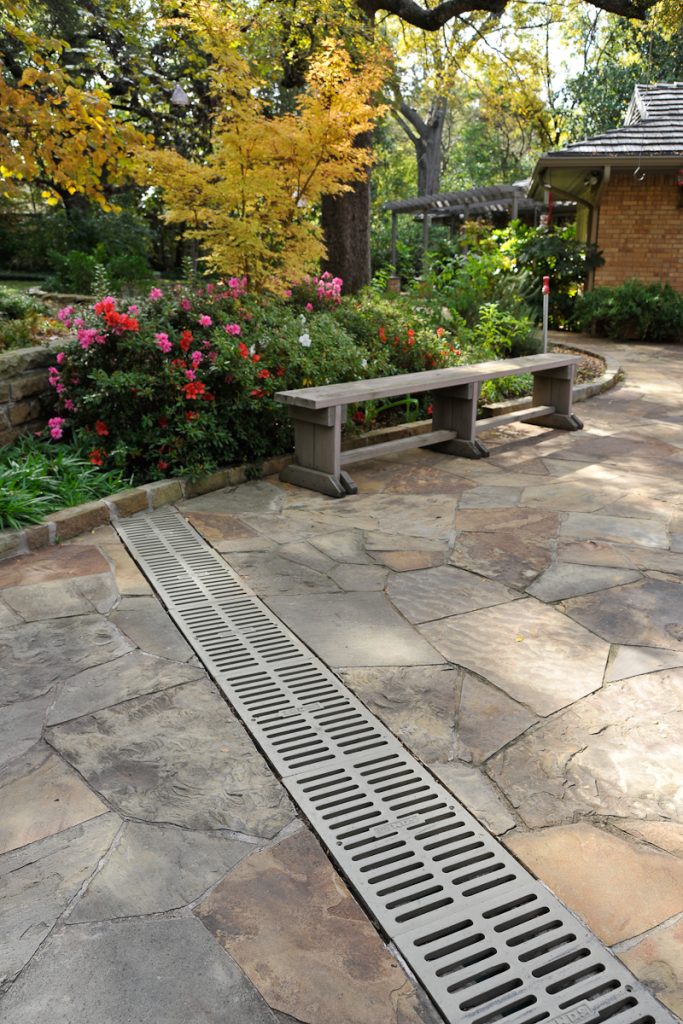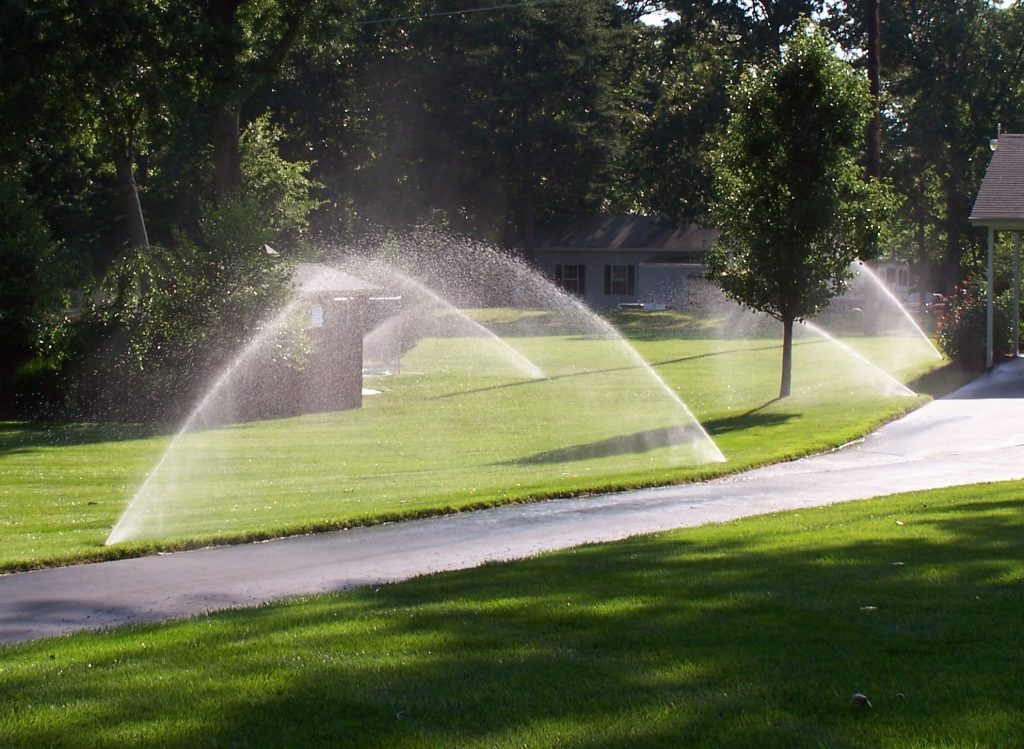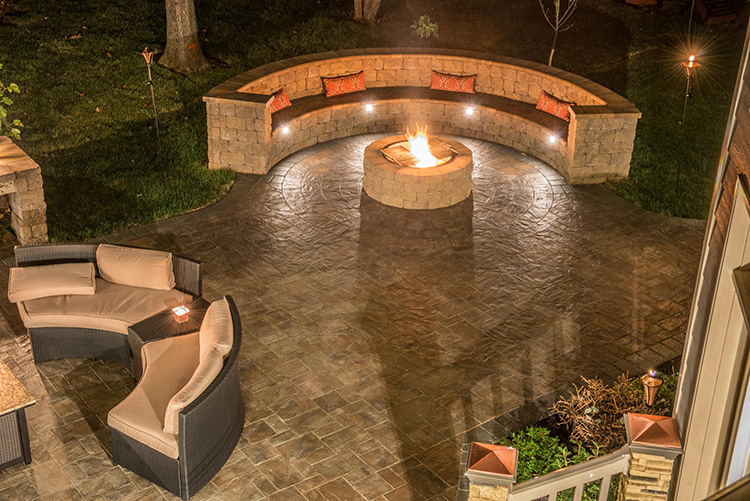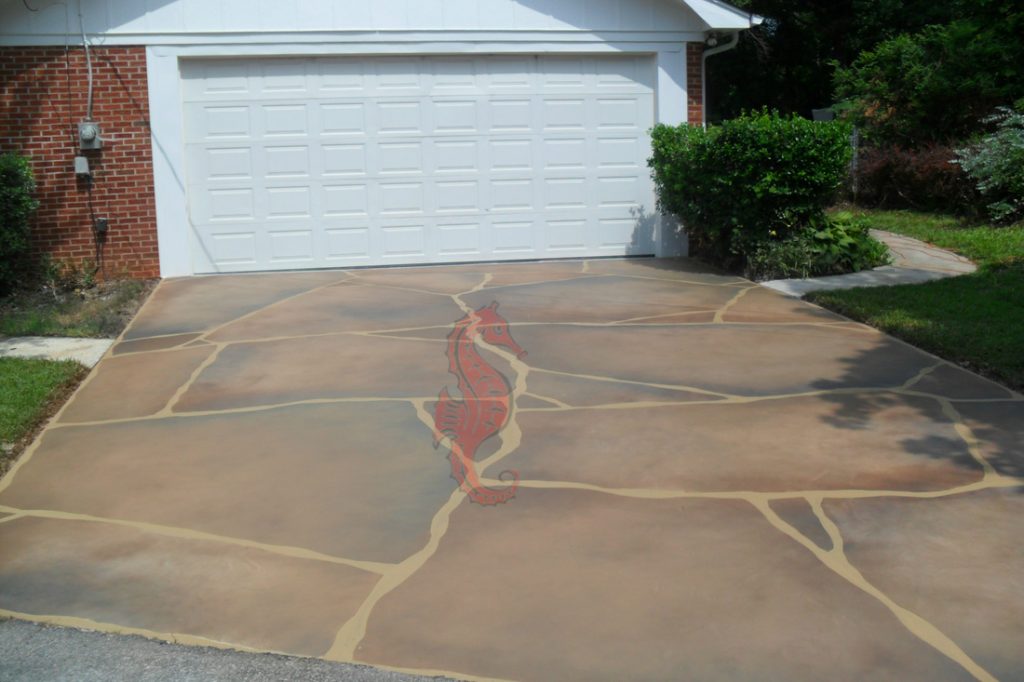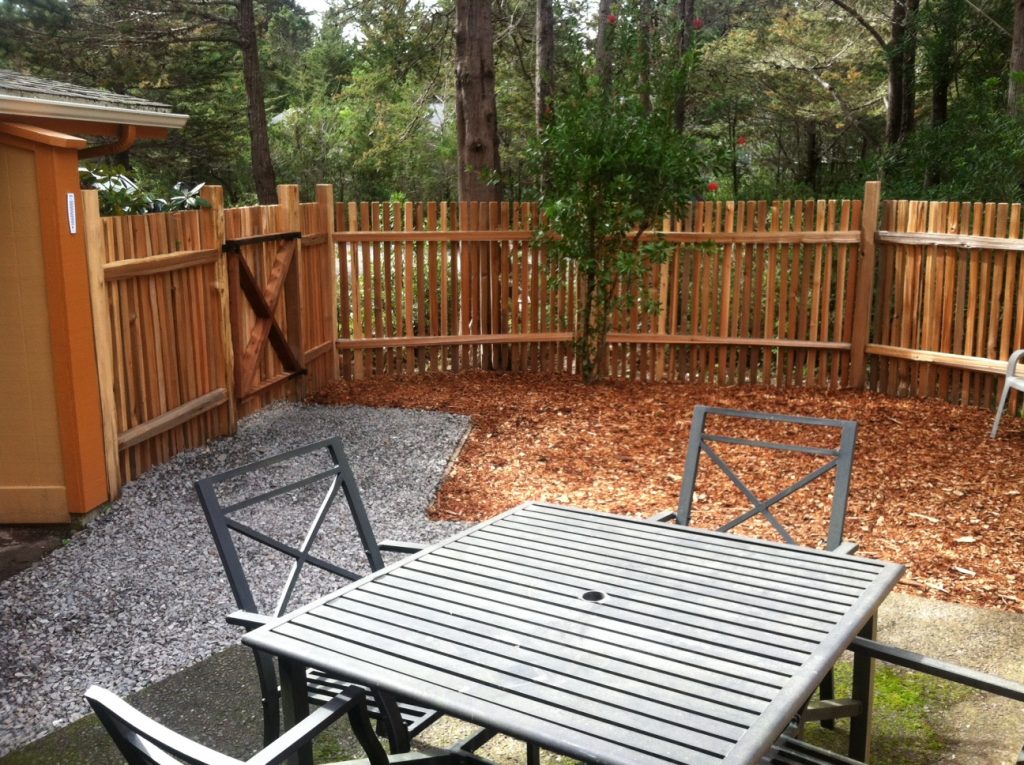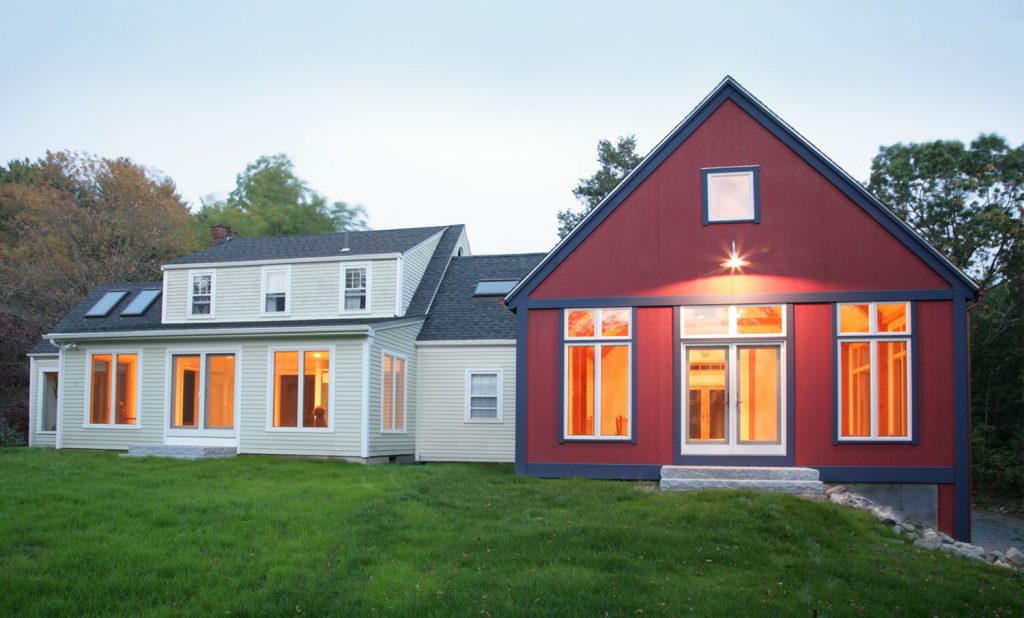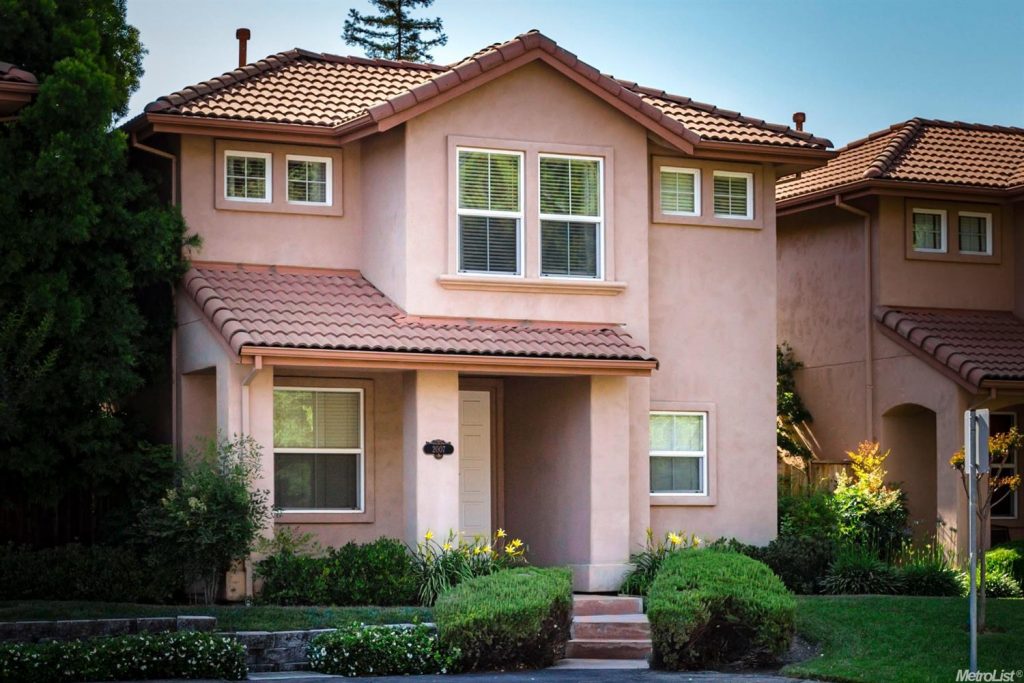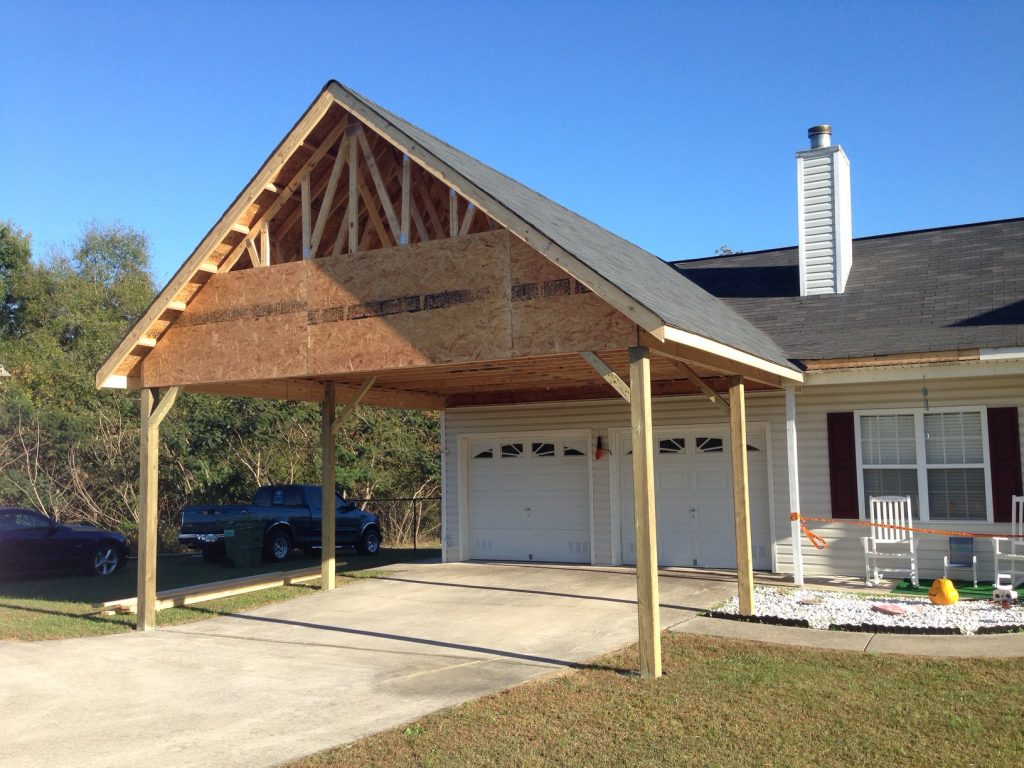Home improvement in the spring is all about getting outdoors, enhancing the exterior of your home, and improving its curb appeal for the upcoming summer months and rest of the year. “Why bother with the curb appeal?”, you may ask. Well, curb appeal normally ties in with the greater enjoyment of your home, as well as better return on investment or ROI for your property.
The obvious considerations are landscaping improvements. Half of our list is devoted to those type of projects and the other half are home exterior and structural improvements. In a few instances, an update or inspection may be all that is needed, but since that may lead to a significant upgrade, it has made our list.
Landscaping Improvements
1. Improving Yard Drainage
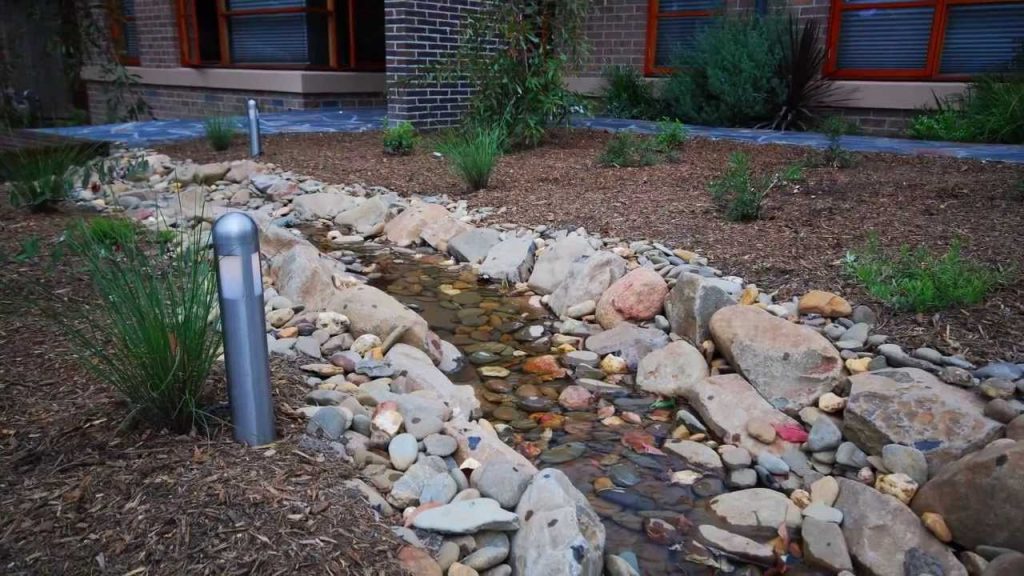 via Dry Creek Bed
via Dry Creek Bed
The need for this improvement stems from the obvious over saturation of water on your property. Soggy yards are not only hard to navigate through but can damage turf. If not addressed, the problem is likely to worsen.
The worst-case scenario occurs when water collects near your home and, over a period of time, negatively impacts your foundation, possibly leading to a leaky basement.
The solution is as simple as using gravity to slope water from one spot to another spot, or to multiple spots. There are several methods to tackle the solution, and often a combination of steps is the best approach.
An obvious place to start is making sure your home’s drainage system is in working order. Clean gutters and downspouts, which is a great project to tackle each spring.
After that, make sure the lower end of the downspout is directing water a good distance away from your home’s foundation. Ideally, you are directing the water to the yard’s drainage system for further discharge or distribution.
Yard drainage takes a bit of ingenuity and combines that with scientific principles. A landscaping contractor has experience to implement a solution that will work best for your property, or ones just like it.
The basics though, are to make note of troubled spots, observe how water moves or remains stagnant over all areas of your property and come up with plan of action. A diagram or site plan that focuses on terrain and water movement (via arrows) can be of tremendous help.
From here, it is then about grading or sloping the property as one possible way to tackle the problem. Alternative and well tested solutions use various drainage devices to move water either off the property or around it, so distribution is as even as possible.
Cost: On average, improving yard drainage will range in cost from $2,750 to $7,500 for a typical project. The higher price accounts for additional underground devices that may be used in the sloping. Much of the cost deals with labor to pay for someone to do the work that goes with grading and digging.
Pros: Less areas on your property that are swampy, reassurances that foundation will not be inundated with water, redistribution of water offers better growth within various regions of your land – such that gardens can be had where previously they may have been ruled out.
Cons: Very little curb appeal with this project, creates an additional area of ongoing maintenance though that ought to be offset by the fact that an original problem is no longer a factor.
Additional consideration: ROI is between negligible and non-existent for this project because you are fixing a flaw more than upgrading an existing an aspect of your property. The next buyer of your home expects drainage to be in working order.
2. Installing a Sprinkler System
The first project was about removing or redirecting water from your property, this one is about adding it for irrigation purposes. Gotta love the irony. A sprinkler system though seeks to effectively distribute water in an even fashion and remain unnoticeable when not in use.
Positioning sprinkler heads, digging trenches for underground pipes or hoses, and maintaining turf integrity are all tasks best left to a landscaping professional.
While you can certainly save on professional labor costs, the potential to do things incorrectly or worse, damage your property outweighs the costs that it takes to hire and pay for a landscaping crew to do this job.
Cost: Prices for fully installed sprinkler systems range from $2,500 to $5,500. The size of your property, labor for digging up and later restoring those areas, along with quality of the system account for most of the cost.
Pros: The return on investment for this project isn’t best measured in monetary value. It’s a hidden improvement that has little curb appeal other than a well irrigated yard.
But the return is still significant. Coupled with a yard drainage system, your yard will flourish for a long time to come and will no longer require you to lug a hose around spending 20 minutes daily on manual irrigation.
Cons: It’s expensive when compared to the desire some get from spending 20 minutes daily on manual irrigation. Plus, if something in the system is not working properly, it can be challenging to determine the problem or expensive to fix it.
3. Installing a Deck or Patio
Now, let’s go above the ground. In many home exterior projects, a site plan is helpful and a building permit is necessary (with the site plan often being a pre-requisite). For a deck or patio installation this is often the case.
Variations in layout and designs are plentiful. The resulting space may be attached to the house or detached. It may be enclosed by a fence, covered via a Pergola, and/or include an exterior kitchen.
Consideration of materials is a significant factor and will drive costs. Both projects benefit significantly from professional installation. The primary differences between the two are the materials.
Decks tend to use wood or composite material for the deck surface. Patios tend to use stone or gravel. The other difference is decks are usually raised higher off the ground and will therefore have steps in one or more spots that descend to the ground level.
The great news is once this spring project is completed, you’ll have a livable space for the whole summer.
Cost and ROI: On average, a new deck will cost between $7,500 to $22,750 to install. The overall size will impact the final price, but typically most decks are 200 to 500 sq. ft.
Materials will determine the price per sq. ft., but you can plan to spend $25.00 to $45.50 per sq. ft. for a pressure treated wood deck. This price includes a site plan, building permits, professional installation, and warranty.
Patios are much less expensive, ranging from $1,500 to $7,500 per completed project, on average. Patios also require less maintenance. A gravel patio can easily be had for well under $1,500, while flagstone is the premium material, costing $10.50+ per sq. ft. installed.
With both projects, you can plan on additional costs as you’re probably going to have furniture, throw rugs and other accessories such as an outdoor fire chimney as part of the decor. The more you add to it, the more it feels like an extension of your interior living space.
ROI is fairly substantial for both projects. Patios will generally return 55% of the costs and may go much higher if using quality material plus designed supremely well.
Decks will return at a rate of 80% or higher, with quality design being a key factor. On our list of ten items, decks would surely be in the top 5 in terms of ROI.
Pros: an additional living space, viable ROI, and opportunity to blend interior accommodations with your properties landscape.
Cons: not a space that is usually used year-round, has very little curb appeal, repairs and maintenance can add to initial investment.
4. Resurfacing Your Driveway
Finally, an item on our list that does have curb appeal. More often than not, resurfacing is actually repairing, but the end result is often an upgrade in material as well as appearance.
The overall surface area, along with curves and slope will impact both cost and time it takes to complete this project.
Concrete is the primary material used in resurfacing, but nothing says you must stick to a bland, single gray color. Flagstone, pavers, and brick can line edges to enhance the overall appearance. Stamped concrete can provide design throughout your entire driveway.
Cost: Due to variation in size and complexity of the job, the average costs are challenging to convey. You can plan to spend a minimum of $2,500 for a professional installation, and unless your driveway is unusually long, less than $10,500 on the high end is typical for resurfacing.
- Concrete (basic) costs about $5.50 to $8.50 per sq. ft.
- Stamped concrete generally runs $8.50 to $15.00 per sq. ft.
- Paver material is $3.50 to $10.50 for mid-grade quality, but plan on paying substantially more for professional installation and special equipment needed for quality results
- Flagstone on average costs $15.50 to $20.50 per sq. ft. installed
- Brick costs about $12.50 to $20.50 per sq. ft. installed. The material itself is between $4 and $8
- Gravel, for the budget conscious, is $1.50 to $2.50 per sq. ft.
- Asphalt will run you $3.00 to $5.50 per sq. ft.
In terms of ROI, the materials and design make a world of difference. Going with bland or inexpensive resurfacing meets all of the pros below but will garner 45% to 50% return rates. Quality design that is in great condition can fetch up to 75% ROI.
Pros: level surfaces are a joy to drive on, quality installation has excellent curb appeal, ROI is decent.
Cons: No inherent cons to the project itself, just the materials and design. Color(s) of the driveway ought to match or complement your home’s exterior. Gravel and concrete will last the longest, while concrete is difficult to repair and gravel moves or is easily displaced.
The more expensive stone materials will crack like concrete but are easier to replace. Stone materials may look more sophisticated, yet they don’t last as long.
5. Installing a Fence
Adding a fence to your property usually serves one to four purposes: increasing privacy, enhancing security, marking property lines, and keeping certain creatures out, while preventing others (we call kids and pets) from leaving.
Materials are plentiful and design options are limitless considering height can vary, even along the same fence line. Late spring is usually the opportune time to dig the holes for post installation.
Before getting too far though, consider the impact a fence will have on the neighborhood, especially those who will have to see its exterior on a daily basis. Neighbor input isn’t required but makes for better relations.
Cost: This is charged by the linear foot for installation. Costs on average range from $6 to $25 per linear foot installed. Materials can be metal, composite, wood, wire, stone and even invisible (to keep pets in).
Building permits and a site plan are often required when exceeding a certain height, usually 3 feet or higher. If the fence is within your own property to say contain a garden, there is less need for permits or checking with neighbors.
ROI will hover around 50% unless going with a well designed and constructed stone or metal fence, which can return at 70% or more.
Pros: Besides the purposes mentioned above, designs and ornamental features can enhance their appeal, some fences can also shield from noise.
Cons: The DIY approach for installation is a two-person labor intensive project, wood fencing requires ongoing maintenance, the impact on the neighborhood isn’t sometimes realized until well after the fence is installed.
Home Exterior Upgrades
6. Replacing Windows
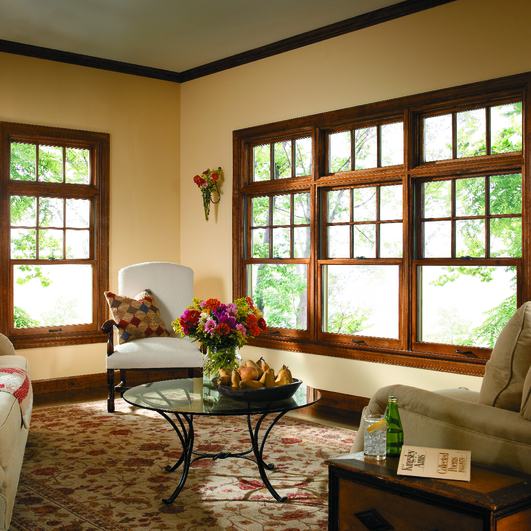
via Pella
Most homes have between 8 and 15 windows around the entire exterior. Replacement is usually sought when the frame or sill material has worn down. Some people consider upgrading to increase energy efficiency.
Materials will often match the home’s trim, such that wood trim has wood windows, vinyl trim uses vinyl windows, but given how far composite materials have come in mimicking wood, this isn’t a hard fast rule.
Window type, whether it be double hung, sliding or some other variation will drive costs as much as labor. While the handy DIY’er can tackle this project, a professional is far more efficient.
If repairs arise, a pro overcomes issues in short order. Having open gaps into your home during the replacement, or repair process, is obviously undesired and even more reason to have contractor be in charge of this spring project.
Cost: Replacement windows range from $650 to $1,000 per vinyl window replaced, on average. The more windows you are replacing, the more likely a deal will be made in price per window.
Frame repair costs are unknown until the window is actually removed and the extent of the issue is properly assessed. Generally, replacing all old windows in a home with vinyl replacement windows will run between $13,000 and $20,000 (assuming 20 windows per project).
ROI is very good for this project, with average returns between 71% and 78%.
Pros: Modern windows offer excellent options for increased energy efficiency, new windows mean less maintenance, and curb appeal is usually good when this project is completed.
Cons: the need for repairs will add to the cost and is challenging to budget for, due to the high expense some may forego this in favor of other projects.
7. Updating or Upgrading your Siding
For this spring project, an update may be all you need. But spring is the time to walk around and make note of the condition of your siding. If unsure what is fair condition or better, then hire a contractor to do that inspection.
Spring is also the time to clean the surface of the material. For fiber cement, vinyl, or stone material, this ought to be done annually. The process takes time but is fairly easy. With wood, it may be time to repaint the surface.
During inspection or cleaning, you may see that repairs are necessary, or that it’s time for a full upgrade with new siding. While new siding is one of the more costly upgrades on our list, it also offers one of the highest returns.
Cost (for replacement siding): So many material options, we can’t cover the costs for all of them. Vinyl is the most economical option, and on average starts at $15,000 at $7.50 per sq. ft. installed for a typical two-bedroom home with 2,000 sq. ft. of siding.
Fiber cement siding on such a house will generally start around $25,000 at $12.50 per sq. ft. installed. Wood and metal (aluminum) start around $20,000, and stone and brick are in the mid $30,000 range or higher.
Wood has perhaps the lowest ROI coming in around 62%, while vinyl and fiber cement are around 80%. Metal and stone generally have 90% rate of return for their siding options. When quality trim is part of the installation, you can bump each of these percentages even higher.
Pros: Of all projects on this list, new, clean, or refinished siding arguably has the greatest curb appeal. Upgraded siding can increase your home’s insulation and energy efficiency.
Cons: Expense would be the biggest drawback, and material selection may mean ongoing maintenance considerations beyond initial investment, though vinyl and stone tend to be very low maintenance.
8. Updating or Upgrading your Roof
Similar to siding, spring is the time to have your roof inspected. Winter months can contribute significant wear and tear. Unlike siding, this isn’t an inspection for just anyone. It’s perhaps best to have a trusted roofing contractor climb up, look around and let you know the status.
Minor repairs are what you hope to be worst case scenario. But part of the reason for inspection is to notice if repairs are beyond the minor stage. A roofer can also let you know whether gutters need cleaning.
At any rate, an upgrade to your roof with replacement may be what’s called for, and/or the contractor would best be able to determine how much life your current roof has left.
Cost: Again, there are many material options, but with this type of upgrade, conforming to what the neighbors in your region have makes sense. Asphalt shingle is the #1 material, and on a typical house runs about $11,000 to start.
Premium shingles or other premium materials like wood and metal, will generally exceed $14,000 for a typical roof replacement project.
The great news is the ROI for roof replacement is usually excellent. Plan on 70% return or higher depending on the material you go with. ROI exceeding 100% is possible with this home improvement.
Pros: top notch ROI, very good curb appeal, enhanced protection to upper layer of your home
Cons: if your roof is not broken, then don’t take on the burden of this expense. Materials each have their own pros and cons, though metal and stone tend to have pros that outweigh all cons.
9. Upgrading your Garage Door
Our final two items are similar structural changes, that don’t break your bank. In fact, they offer the most bank for your buck.
Garage doors come in three primary materials: wood, composite and metal (i.e. steel). There’s nothing complex about this upgrade. The key is to select a material you are fond of, and which has a color that complements your home’s exterior. How fancy you get with accessories like windows, and other design items is up to you.
Cost: Standard doors are 16 x 7 feet, and on average range from $1,100 to $2,500 installed. Material and quality of labor are the key factors in the cost.
ROI in 2022 for garage door replacement is 85%.
Pros: Great curb appeal if done right, great ROI, a relatively inexpensive upgrade.
Cons: Only based on material variations. Each has positives and weaknesses. Composite doors tend to be more expensive; metal ones may dent or scratch, wood may require ongoing maintenance.
10. Upgrading your Main Entry Door
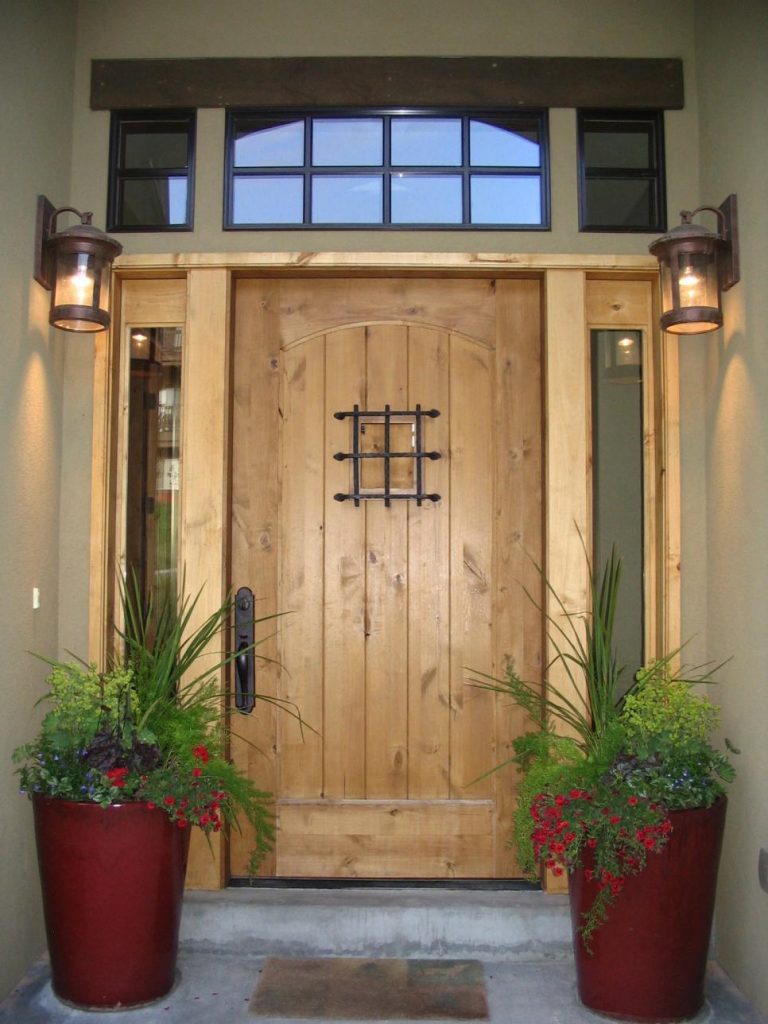 via HGTV
via HGTV
Circa 2015, this structural upgrade topped many online lists as #1 upgrade offering most bang for your buck. Similar to a garage door, when done right, the curb appeal is top notch.
But unlike the garage door, a prospective buyer is likely to go through this door immediately and into what could be their new home. Thus, the more inviting and well-designed that entry is, the better.
Steel, fiberglass, and wood are the primary materials. The project can get expensive fast if considering upgrades around the door such as sidelights. Security is another consideration that can drive up the cost.
Costs: For a basic door, weathering strip, handle and latches the costs for materials range from $1,250 to $2,500 on average. Fiberglass tends to be more expensive than the others, but economical grades exist for each. The more secure and how decorative the door is, the higher the expense.
For this year, the ROI remains what it has been in recent years, which is 75% to 80%. While not as great as other items on this list, it is still better than many other home upgrades. The bang for the buck is the main selling point.
Pros: Excellent curb appeal, perhaps 2nd only to new siding, fairly inexpensive, good ROI
Cons: replacement may actually exposes need for repair in the frame thus increasing costs. Besides this it is mainly material considerations and their varying weaknesses that make for possible disadvantages of a particular entry door.
